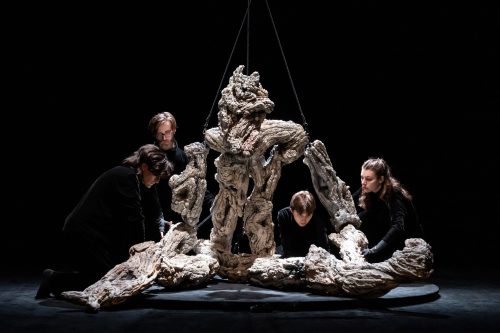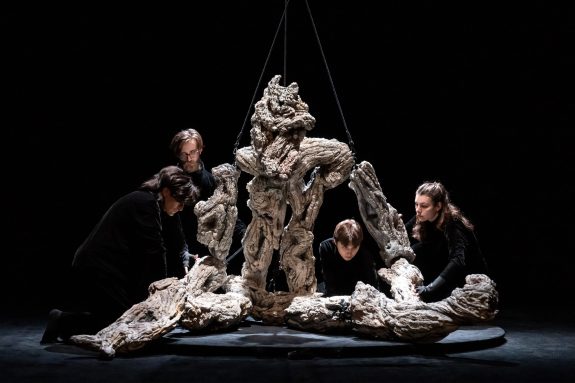 United States Huang Ruo, Book of Mountains and Seas: Artists of Ars Nova Copenhagen / Miles Lallemant (conductor). BroadStage, Santa Monica, 13.4.2024. (JRo)
United States Huang Ruo, Book of Mountains and Seas: Artists of Ars Nova Copenhagen / Miles Lallemant (conductor). BroadStage, Santa Monica, 13.4.2024. (JRo)

Production:
Director and Production – Basil Twist
Lighting – Ayumu ‘Poe’ Saegusa
Creative – Beth Morrison
Puppeteers – Emily Batsford, Lute Breuer, Ben Elling, Rosa Elling, Rachel Schapira, Ashley Winkfield
Ars Nova Copenhagen – Anna Schubert, Melanie Russell, Mari Øyrehagen, Hanne Marie le Fevre, Laura Lamph, Iris Oja, Luís Toscano, James Robinson, Jakob Skjoldborg, Asger Lynge Petersen, Rasmus Kure Thomsen, Mikkel Tuxen
Percussion – Erica Hou, Yuri Inoo
Ancient Chinese texts, meditative music, dramatic lighting and subtle puppetry merge in Huang Ruo’s Book of Mountains and Seas to create a hybrid performance piece of vocal theater for twelve singers, six puppeteers and two percussionists. Under the umbrella title of LA Opera’s ‘Off Grand’ offerings, the BroadStage in Santa Monica was an intimate venue for Ruo’s work. The warm and handsome interior proved the ideal setting for this sometimes entrancing, sometimes puzzling work.
Creation myths culled from the classic text of Mountain and Seas, transcribed as early as the fourth century B.C.E., form the basis of Ruo’s work. The myths, which exist in the original text alongside descriptions of geological features, fanciful beasts, religious principles and medical information, are no more than short paragraphs. Ruo has expanded on these stories of the formation of the natural world and makes reference to our planet’s survival in the twenty-first century.
Members of the vocal ensemble Ars Nova Copenhagen interpreted Ruo’s score. According to the composer, he drew inspiration from Chinese folk music and Western modernism. More than Chinese modes or the Western avant-garde, I noticed references to Gregorian chant mingled with the liturgical music of various world religions.
The singers were attired in black velvet robes, their forms disappearing on the darkened stage with only their faces illuminated. Their solemn and static posturing, coupled with hands holding scores like prayer books, added to the sense that we were experiencing a religious rite. This was not a fanciful chorus of emotive vocalists. Instead, the fancy was provided by Basil Twist’s troupe of puppeteers.

Puppetry was muted, however, in favor of what I would call scenic manipulation. The exception was the last scene, ‘Kuā Fù Chasing the Sun’ – the highlight of the evening both musically and dramatically. A massive puppet of Kuā Fù, created from material that looked like tree trunks or lava rock, was assembled onstage by the puppeteers and manipulated to run in place, simulating the giant’s ceaseless quest to catch the sun. Running from east to west in futile pursuit, he drained the rivers (a mass of billowing white silk) to quench his burning thirst. The magic of Twist’s puppetry was that this creature, though an abstraction of parts, elicited genuine pathos in its childlike simplicity and determination.
Minimal text in Chinese, English and an invented language introduced each of the scenes, but with few surtitles and little in the way of dramatic clues, the audience had to be content with watching and listening to a more or less staged concert. This was undoubtedly a poetic and meditative experience, but it was at times inert and repetitive. This was particularly true of the first two scenes.
Scene III, ‘The Legend of Ten Suns’, felt more robust and dramatically cohesive, with echoes of Carl Orff’s cantata, Carmina Burana. Ten suns lived contentedly on a mulberry tree in the eastern sea, but on the day that they broke their formation and all shone at once, the crops dried up and animals and humans died. The god of archery killed nine of the suns but spared the last to light the earth. The suns, represented by paper lanterns wielded on tall sticks, glowed orange and red against the darkened stage. As the suns bobbed and moved towards the audience, they felt alive, their personalities distinct and playful.
The lighting by Ayumu ‘Poe’ Saegusa created atmosphere and poetry and was as important as Twist’s set design. Percussionists Erica Hou and Yuri Inoo were subdued during the a cappella singing of the first and second scenes but were a more integral part of the performance in the final two scenes, adding tension and drive with propulsive drumming in the final section.
As told in the myth, when Kuā Fù dies he drops his walking stick on the ground, and it turns into a forest of blossoming peach trees. After Kuā Fù’s body is disassembled into pieces symbolizing his death, the singers massed on stage to be showered by falling petals – a tender conclusion to this elegiac tale.
Jane Rosenberg
